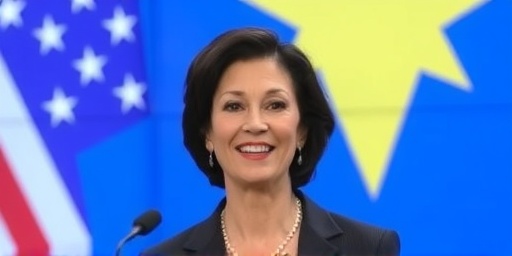In a stark reminder of the economy’s delicate balancing act, Federal Reserve Governor Lisa Cook delivered a sobering update on U.S. inflation, pegging it at a persistent 2.8% amid the ripple effects of ongoing tariffs. Speaking at an economic forum in Washington D.C., Cook emphasized that while the Federal Reserve remains committed to its 2% target, the path forward could be gradual as tariff-induced price pressures continue to linger. This comes as the labor market shows early signs of cooling, with unemployment edging up to 4.3% in the latest data, raising questions about the sustainability of recent growth.
Cook’s comments, made during a panel discussion on monetary policy and trade dynamics, underscore the complex interplay between global trade policies and domestic economic stability. Investors and policymakers alike are watching closely, as any misstep could either prolong inflationary woes or tip the scales toward recessionary risks. The Federal Reserve‘s dual mandate of price stability and maximum employment now faces heightened scrutiny in this environment.
Cook Highlights Tariff-Driven Inflation Surge
Federal Reserve Governor Lisa Cook didn’t mince words when addressing the root causes of the current inflationary environment. ‘Tariffs imposed on key imports have contributed significantly to the elevated inflation we’ve seen,’ she stated, pointing to how these measures have jacked up costs for businesses and consumers alike. The U.S. inflation rate, as measured by the Consumer Price Index (CPI), stands at 2.8% year-over-year, a figure that exceeds the Fed’s preferred 2% benchmark by a notable margin.
These tariffs, largely stemming from the Trump-era trade wars with China and other trading partners, have had a lasting impact on supply chains. According to recent Bureau of Labor Statistics (BLS) reports, imported goods—particularly electronics, machinery, and consumer products—have seen price hikes of up to 15% in some categories due to these duties. Cook noted that while some effects were front-loaded in 2018 and 2019, residual pressures persist through higher input costs for manufacturers, which are then passed on to end-users.
To illustrate the breadth of this issue, consider the automotive sector: Tariffs on steel and aluminum have increased vehicle production costs by an estimated 2-3%, contributing to a 4.5% rise in new car prices over the past year. Economists at the Federal Reserve have modeled that without these tariffs, core inflation could be as much as 0.5 percentage points lower. Cook’s assessment aligns with broader Fed projections, which anticipate that inflation will ease only as these trade barriers subside or as domestic production ramps up to offset import dependencies.
Yet, Cook tempered her warnings with optimism, suggesting that ‘once the tariff effects wane, we can expect a more measured return to our 2% goal.’ This forward guidance is crucial for markets, as it signals the Fed’s reluctance to hike rates aggressively in the near term, potentially averting a sharper economic slowdown.
Labor Market Cools Amid Rising Unemployment
Shifting focus to employment, Cook described the labor market as exhibiting ‘modest cooling,’ a development that could provide some relief to inflationary pressures by curbing wage growth. The unemployment rate has climbed to 4.3% from 4.1% in the previous quarter, according to the latest BLS jobs report. This uptick, while slight, marks the highest level since mid-2021 and reflects a softening in hiring across several sectors.
Nonfarm payrolls added a respectable 206,000 jobs in the most recent month, but that’s down from the 250,000-plus monthly average seen earlier in the year. Industries like manufacturing and retail, which have been hit hardest by tariff-related cost increases, are leading the slowdown. For instance, manufacturing employment dipped by 12,000 jobs, as companies grapple with higher material costs and uncertain trade environments.
Cook elaborated on these trends during her remarks: ‘The labor market remains resilient overall, but we’re seeing pockets of weakness that warrant close monitoring.’ Wage growth, a key driver of inflation, has moderated to 3.9% annually, down from peaks above 5% during the post-pandemic recovery. This deceleration is welcome news for the Federal Reserve, as it reduces the risk of a wage-price spiral where higher salaries fuel further price increases.
However, the rise in unemployment isn’t uniform. Urban areas with heavy reliance on import-dependent industries, such as those in the Midwest, are experiencing sharper increases, with rates approaching 5%. Demographically, younger workers and those in blue-collar roles are bearing the brunt, highlighting potential inequalities in the cooling labor market. Analysts from Goldman Sachs predict that if tariffs persist, unemployment could stabilize around 4.5% by mid-next year, assuming no major policy shifts.
Tariffs’ Long Shadow on Economic Recovery
The enduring influence of tariffs extends far beyond immediate price tags, casting a long shadow over the broader U.S. economic recovery. Implemented initially to protect domestic industries and address trade imbalances, these measures have instead amplified inflationary risks at a time when supply chains are still recovering from COVID-19 disruptions. Cook’s speech comes against the backdrop of renewed debates in Washington about trade policy, with potential escalations if geopolitical tensions rise.
Quantitative data paints a vivid picture: The Peterson Institute for International Economics estimates that tariffs have cost U.S. households an average of $800 annually through higher prices, while reducing GDP growth by 0.2-0.5% per year. In the context of inflation, the Personal Consumption Expenditures (PCE) index—the Fed’s preferred gauge—mirrors the CPI at 2.6% core rate, with tariff-impacted goods like apparel and furniture showing persistent elevation.
Business leaders echoed Cook’s concerns. In a follow-up interview, National Association of Manufacturers President Jay Timmons said, ‘Tariffs are a blunt instrument that’s hurting more than it’s helping right now, especially with inflation already in the mix.’ This sentiment is shared by small business owners, who report in surveys that 60% have raised prices due to tariff costs, further entrenching inflationary expectations.
Regionally, the impacts vary. Coastal states with diversified economies feel less pain, while heartland manufacturers face compounded challenges from both tariffs and a softening labor market. The Federal Reserve’s Beige Book, released last week, noted ‘widespread mentions of tariff-related cost pressures’ across districts, from Boston to San Francisco.
Fed’s Balancing Act: Inflation Targets and Policy Outlook
As the Federal Reserve navigates these headwinds, Cook’s remarks provide a window into the central bank’s strategic thinking. The Fed has held interest rates steady at 5.25-5.50% since last summer, but officials are divided on the timing of cuts. Cook advocated for patience, stating, ‘We must ensure that inflation is on a sustainable path back to 2% before easing policy, even as the labor market shows cooling signs.’
Projections from the Fed’s September dot plot indicate that most members expect two rate cuts by year-end, contingent on inflation data. However, persistent tariffs could delay this timeline, as higher import costs might necessitate prolonged restrictive policy. Economists at JPMorgan Chase forecast that if tariffs expand under a new administration, inflation could hover above 3% into 2025, complicating the Fed’s efforts.
The interplay between inflation and unemployment is particularly poignant under the Fed’s dual mandate. With the labor market unemployment rate at 4.3%, the economy is nearing what some call ‘full employment’ territory, but any further softening could trigger broader concerns. Cook referenced the Phillips Curve framework, noting that the traditional inverse relationship between unemployment and inflation is holding, albeit loosely, in the current tariff-laden environment.
Market reactions to Cook’s speech were muted, with the S&P 500 dipping 0.3% and Treasury yields holding steady. Bond traders interpret her words as a signal of steady-handed policy, avoiding panic over imminent rate hikes.
Implications for Consumers, Businesses, and Global Trade
Looking ahead, the signals from Federal Reserve Governor Cook paint a picture of cautious optimism tempered by real risks. For consumers, sustained inflation at 2.8% means continued pressure on household budgets, particularly for essentials like groceries and energy, where tariff effects on agricultural imports have driven up food prices by 5.2% year-over-year.
Businesses face a dual challenge: Investing in domestic alternatives to tariffed imports requires capital amid a cooling labor market, where finding skilled workers is becoming tougher with unemployment at 4.3%. Supply chain diversification efforts, such as nearshoring to Mexico, are gaining traction but won’t yield quick wins.
On the global stage, U.S. tariffs continue to strain relations with trading partners. The European Union and Canada have retaliated with their own measures, potentially escalating into a broader trade conflict that could further inflate costs. Cook urged policymakers to consider ‘holistic approaches’ that balance protectionism with inflation control.
As the Federal Reserve monitors these developments, upcoming data releases—like the next CPI report and jobs figures—will be pivotal. If inflation eases toward 2.5% and unemployment stabilizes, rate cuts could materialize sooner, boosting confidence. Conversely, entrenched tariff effects might prolong the high-rate era, testing the resilience of the labor market and overall economy. Stakeholders from Wall Street to Main Street are bracing for this uncertain trajectory, with the Fed’s next moves hanging in the balance.









